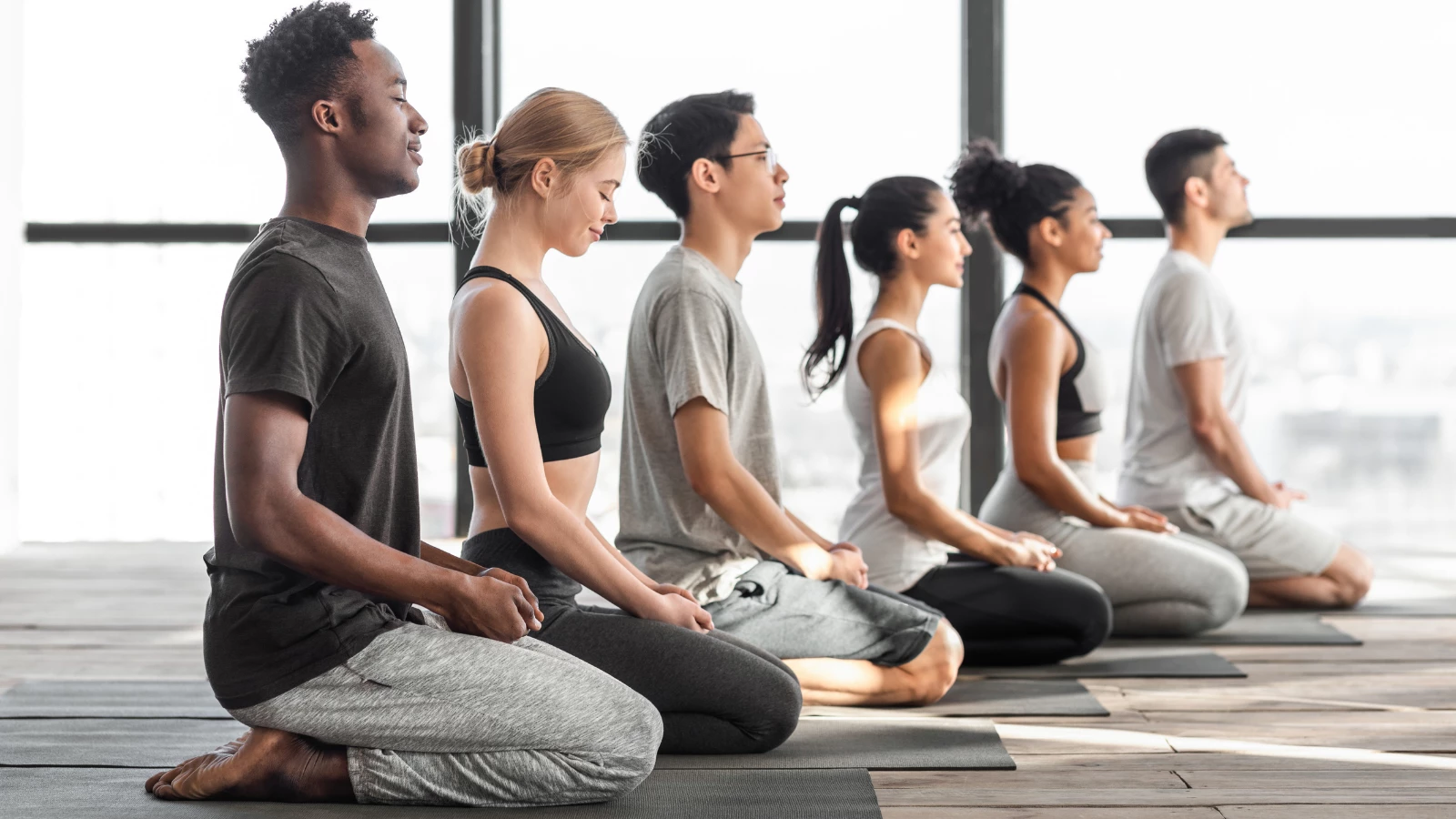Namaste and Yoga: Honoring Body, Mind and Intellect

According to what I learned in India from my grandfather and other Sanskrit scholars, “namaste” is a revered Sanskrit word with a deep and profound meaning. It’s not a simple act of bringing your hands into Anjali mudra and muttering the word under your breath. It’s also not just a general greeting, like “hello” or “good morning.” You have to mean it when you are saying it because words like namaste have deep effects on the body, mind, and intellect as they can transform an individual.
This seven letter Sanskrit word is made of two words: namas + te:
Nama = bow, obeisance, deference, awe, salutation, acknowledgment, adoration, worship, respect, adulation, esteem, appreciation.
Te (do not stress on the Te as in Tea, instead think of the name Theo and say Te similarly such that it rhymes with They). Depending on the context, preceding or the succeeding word, Te could mean = you, they, that.
The appearance of the “s” letter has to do with Sanskrit phonetics and grammar that is not relevant to this post.
If you have an individual saying Namaste to another individual or to a group, it, therefore, would literally mean: saluting you/you all, obeisance to you/you all, acknowledging you/you all, worshipping you/you all, adoring you/you all.
Namo vaḥ and Namo vam, are enclitic words and confined to Sanskrit grammar. It is rarely used in regular Sanskrit conversation and represent shortened versions of Namas + Te (Namo vaḥ and Namo vam are akin to the English enclitic words “can’t” and “won’t”).
If someone addresses you with a “namaste” and you are generous with your blessings and wish that the addressee (individual or a group) receives twice the benediction/adoration, you reply “Namo Namah.” Namo Namah is Namas Namas (of Namaste) repeated twice for emphasis and simultaneously doubling the blessing. Once again, the use of Namo Namah and not Namas Namas is solely due to Sanskrit grammar and word conjunction.
“Namaskar” is “namaste” in the Hindi language. In the South Indian language, namaste takes the form of “namaskara” or “namaskaram.”

The Power of Language
When you tell someone, “Thanks, I appreciate it,” do you really mean every word or do you say it loosely? Words are not just elements to utter or write, they carry energy and travel through space as vibrations that can impact the receiver both negatively and positively. Notice our feelings and our state when we hear certain pleasing words or violent words. Pleasing words calm and destress us while spiteful/vicious words ruffle us and disrupt our calm demeanor. Namaste is a pleasant-sounding, harmonious, and revered word that has its energetic effects on body, mind, and intellect. And unlike what some fanatics profess, namaste is not bound by religion. Its effect and meaning are beyond any religious connotation.
How to Speak to Body, Mind, and Intellect
In The Koshas: A Yoga Model for Healthy Aging, Beth Gibbs alluded to the five-layer koshas encompassed by the three bodies namely physical, subtle, and causal/karmic, which need to be completely integrated and functioning in harmony to achieve wellness and wholeness. For the sake of simplicity, I will refer to the three bodies physical, subtle, and causal/karmic as body, mind, and intellect. This is relevant because when namaste is uttered consciously, we wish that the energy associated with this term positively affects one or all three aspects of individuality: body, mind, and intellect.

Body: It may sound like a customary greeting similar to hello and is often used in yoga and Ayurveda classes, where the teacher may utter the word at the beginning or end of the class. It is also a customary greeting among Hindus before initiating a conversation and is used with all people, young, old, friends, and strangers. While it may not carry any significance for the addressee or the addressers, in reality, it is extending a warm welcome to each other and showing respect that you are equal to one another.
The utterance of this word strikes an instant connection, clears away any doubts or discordance, and removes any barriers of resistance. Acknowledging the oneness and equality paves the way for an animated conversation. It also marks the beginning or end of a conversation.
There is no customary rule that it has to be said in a yoga class. I do it at the end of my yoga class, to thank the participants for having attended my class, to thank the participants for a meaningful session, and to acknowledge the studio for providing me the space to teach. Just one word to give thanks to everyone involved in the event! In the Ayurveda classes that I teach each month—each class is eight hours long with multiple breaks—we say “namaste” when we take breaks and resume the classes. I do it for the same reasons as mentioned above.

Mind: When you say “namaste,” at the level of the mind, you are recognizing the divinity in yourself and acknowledging the divinity in others. As a teacher of any subject, you want to see the best of your students, and you get the utmost pleasure if your students inculcate and practice your teachings. In a yoga class setting, by saying “namaste,” you are acknowledging mentally that your students gravitate toward the yogic lifestyle (following the yamas and niyamas and gaining expertise over asanas and pranayama) and successfully building and strengthening the connection between the body and the mind. Additionally, namaste serves as a blessing that their mind is set free of materialistic desires so as to prepare the intellect for contemplation.
Intellect: At the level of the intellect, by saying namaste you are acknowledging the “true you” (Purusha) and the true self in others. You recognize that the true you is the same in all others as well. In a yoga class, you are also letting go of your ego as a yoga teacher. No matter how famous and skillful you may be in your asana practice, you continue to be humble, ready to teach and learn from others, inculcating in your student’s positive feelings and experiences, transforming all negative experiences, having no judgment, giving and receiving blessings, and viewing all individuals as a manifestation of that supreme divinity.

Thus, at the highest level namaste is not a loose word but a revered greeting. There is no specific time, venue, or event when this can be said. The argument that it need not be said in yoga class since it is not followed in yoga centers in India does not hold, since there is other yoga-relevant stuff that happens in the West (dog yoga, aqua yoga, couples yoga, tantra yoga, Yogalates, etc) that is not followed in India.
To use this word, you need to be open-hearted and generous with your good wishes and blessings to others and to society. Say “namaste” and let go of your ego and personality, feel open, grounded, and calm. Experience oneness with your true self and see everyone and everything else as an embodiment of that true self: “the oneness.”
You also have a choice of directing the vibrations of this word to just one level or all three levels of individuality—body, mind, and intellect. After saying it, notice if you are experiencing contentment and a sense of accomplishment. It’s a great positive spiral and it results in true happiness.
Now you may understand why I sign off all my mails to Nina (1) with “Namaste.” Thanks to this divine soul, I am able to pen my thoughts and communicate with you all through this blog.
Also, read...
4 Ways to Protect Hands and Wrists in Yoga
Dancer Pose (Natarajasana): Practice Tips And A Beginner Yoga Sequence
Warrior 2: How To Sequence For Healthy Hip Alignment In A Beginner’s Class
Related courses
Need an Energy Makeover? How Yoga Can Help You Boost Vitality
Keys to Finding Inner Strength: A Yogic Wisdom Path to Developing Greater Resilience

Rammohan (Ram) Rao comes from a family of Ayurvedic practitioners and Vedic teachers in India tracing back to the illustrious Vedic-acharya Rishi Kaundinya (although Ram admits he cannot do the Eka pada or Dwi pada Kaundinyasana). With a doctorate in Neuroscience, Ram was a Research Associate Professor at the Buck Institute for Research on Aging. He focused on various aspects of age-associated neurodegenerative diseases with an emphasis on Alzheimer’s disease. In addition, Ram completed the academic training at the California College of Ayurveda (CCA) and received his certification as a Clinical Ayurvedic Specialist. He has been a faculty member of the California College of Ayurveda and teaches in their Nevada City location. Ram is also a dedicated Hatha yoga practitioner and is a Registered Yoga Teacher from Yoga Alliance USA. In his spare time, he offers consultations in YAMP techniques (Yoga, Ayurveda, Meditation & Pranayama). Ram has published several articles in major Yoga/Ayurveda magazines and has been a featured speaker in several national and international meetings and symposia. He is a member of the National Ayurvedic Medical Association (NAMA) and is on the Research Board of the Association of Ayurvedic Professionals of North America (AAPNA).
- Nina Zolotow, Editor of the Yoga for Healthy Aging Blog.


